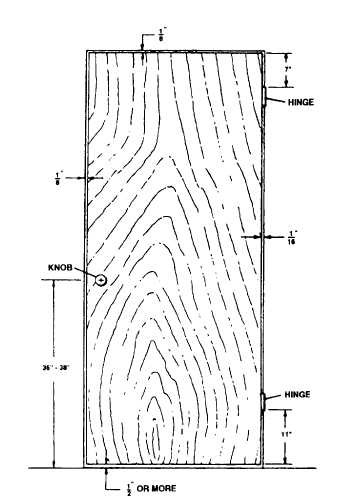Figure 6-27.—Door clearances.
Hinges
figure 6-27. The clearance and location of hinges,
lockset, and doorknob may vary somewhat, but they are
generally accepted by craftsmen and conform to most
millwork standards. The edge of the lock stile should be
beveled slightly to permit the door to clear the jamb
when swung open. If the door is to swing across heavy
carpeting, the bottom clearance may need to be slightly
more.
When fitting doors, you should temporarily nail the
stop in place; this stop will be nailed in permanently
when the door has been hung. Stops for doors in
single-piece jambs are generally 7/16 inch thick and
may be 3/4 inch to 2 1/4 inches wide. They are installed
with a mitered joint at the junction of the side and head
jambs. A 45° bevel cut at the bottom of the stop, about
1 to 1 1/2 inches above the finish floor, eliminates a dirt
pocket and makes cleaning or refinishing of the floor
easier (fig. 6-26, view A).
Some manufacturers supply prefitted doorjambs
and doors with the hinge slots routed and ready for
installation. A similar door buck (jamb) of sheet metal
with formed stops and casing is also available.
DOOR HARDWARE INSTALLATION
Hardware for doors is available in a number of
finishes, with brass, bronze, and nickel being the most
common. Door sets are usually classified as entry lock
for interior doors; bathroom set (inside lock control with
safety slot for opening from the outside); bedroom lock
(keyed lock); and passage set (without lock).
As mentioned earlier, doors should be hinged so that
they open in the direction of natural entry. ‘hey should
also swing against a blank wall whenever possible and
never into a hallway. The door swing directions and
sizes are usually shown on the working drawings. The
“hand of the door” (fig. 6-28) is the expression used to
describe the direction in which a door is to swing
(normal or reverse) and the side from which it is to hang
(left or right).
When ordering hardware for a door, be sure to
specify whether it is a left-hand door, a right-hand door,
a left-hand reverse door, or a right-hand reverse door.
You should use three hinges for hanging 1 3/4-inch
exterior doors and two hinges for the lighter interior
doors. The difference in exposure on the opposite sides
of exterior doors causes a tendency to warp during the
winter. Three hinges reduce this tendency. Three hinges
are also useful on doors that lead to unheated attics and
for wider and heavier doors that may be used within the
structure. If a third hinge is required center it between
the top and bottom hinges.
Loose-pin butt hinges should be used and must
be of the proper size for the door they support.
For 1 3/4-inch-thick doors, use 4- by 4-inch butts; for
1 3/8-inch doors, you should use 3 1/2- by 3 1/2-inch
butts. After the door is fitted to the tied opening with
the proper clearances, hinge halves are fitted to the door.
They are routed into the door edge with about a
3/16-inch back distance (fig. 6-29, view A). One hinge
half should be set flush with the surface and must be
fastened square with the edge of the door. Screws are
included with each pair of hinges.
6-18


